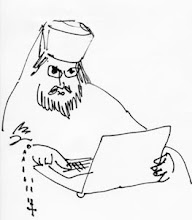 Today is the third Sunday in Lent, on which we celebrate the Veneration (or Adoration) of the Precious and Life-Giving Cross.
Today is the third Sunday in Lent, on which we celebrate the Veneration (or Adoration) of the Precious and Life-Giving Cross.Although this Sunday has much in common with the Feast of the Elevation of the Cross (September 14), it is in fact more directly associated with Pascha, that is, the Feast of the Resurrection. Christ’s Crucifixion and Resurrection are never treated within the Orthodox Tradition as two discrete events: they form two parts of one single action, which together we can call the Passion. Recall that, in the very earliest centuries, the Crucifixion and Resurrection were celebrated as one event; it was only later that the two were in some sense separated, receiving their own liturgical commemorations on different days. This joint veneration is perhaps most concisely expressed in the words we sing today, on the Sunday of the Cross: “We venerate Thy Cross, O Master, and we glorify Thy Holy Resurrection.” From an Orthodox perspective, then, to speak of the Passion of Christ is to speak of both the Cross and the Resurrection as a single event marking the victory over death. The Cross is a symbol of victory, not of defeat.
Metropolitan Kallistos, introducing today's commemoration, says this in his introduction to The Triodion:
The dominant note on this Sunday, as on the two Sundays preceding, is one of joy and triumph. In the Canon at Matins, the irmoi are the same as at Easter midnight, 'This is the day of Resurrection...', and the troparia are in part a paraphrase of the Paschal Canon by St John of Damascus. No separation is made between Christ's death and His Resurrection, but the Cross is regarded as an emblem of victory and Calvary is seen in the light of the Empty Tomb.Christ's Incarnation and Passion are together woven from the fabric of Scripture, as St Hippolytus of Rome puts it so poetically in his treatise, On the Christ and the Antichrist (4):
For the Word of God, being fleshless, put on the holy flesh from the holy Virign, as a bridegroom a garment, having woven it for himself in the sufferings of the Cross, so that having mixed our mortal body with His own power, and having mingled the corruptible into the incorruptible, and the weak with the strong, He might save perishing man.To unravel this metaphor is to discern the mystery of the Cross, which can but only but lead to veneration and adoration.
The web-beam, therefore, is the Passion of the Lord upon the Cross;
and the warp on it is the power of the Holy Spirit;
and the wolf is the holy flesh worn by the Spirit;
and the thread is the grace which by the love of Christ binds and unites the two in one;
and the rods are the Word;
and the workers and the patriarchs and prophets who weave the fair, long, perfect tunic for Christ;
and the Word passing through these, like the combs (or rods), completes through them that which His Father wills.
Some links for the Sunday of the Cross:
- Liturgical texts: Great Vespers and Matins.
- Synaxarion for the Third Sunday of Lent.
- A valuable selection of thirty-four short texts by the Holy Fathers on the Holy Cross.
- Reflections on the Sunday of the Cross by His Eminence, Archbishop Dmitri of Dallas and the South.
- Sermon by Fr George Niozisin on the Veneration of the Precious Cross.
- Professor I. M., Andreyev, The Cross of Christ
- An explanation of the Three-Bar Cross.
We venerate Thy Cross, O Master, and we glorify Thy Holy Resurrection!









4 comments:
I was greatly filled with expectant joy on this Day of Grace while singing the katavasiai of the Canon of the Cross. "O Mati Djevo, i Bogorodice neložnaja," I sang in the First Tone, but I heard resounding inside, "Svjetisja, svjetisja, novij Jerusalime..."
Thank you for this. I was stuck at home with a bad case of strep throat today. It was nice to have some of this in the absence of being able to make it to Liturgy.
Esteban: The parallels between the services for the Sunday of the Cross and Pascha really are striking. What struck me in particular during Matins was the combination of the Resurrectional canon and the Festal canon together (with, of course, the canon to the Theotokos in between the two).
Kevin:
Your comment makes whatever little effort I put into the post seem well worth while; I'm glad it served such a good and worthy purpose.
I have something of a love-hate relationship with the internet, but there really are riches out there, if one knows how to use it with discernment.
Father: This juxtaposition of the Canons of the Resurrection and the Cross is precisely what I had in mind. And as I suggested above, it all struck me in a poignant way this time, because both Canons are crowned by katavasiai that are prosomia of those of the Paschal Canon. Singing those katavasiai in the Paschal melody was tremendous. We half-way to the goal!
Post a Comment